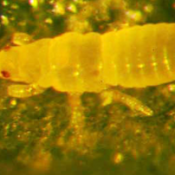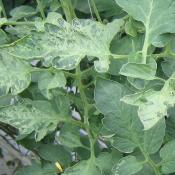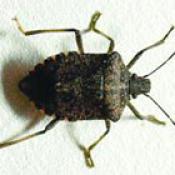Poinsettia Thrips
July 2018
Successful partnership prevented establishment of new pest
MPI and affected industry GIA partners including TomatoesNZ have agreed to “stand down” the Poinsettia Thrips (Echniothrips americanas) investigation, after surveys found no further specimens.
The “Unwanted Organism” was discovered in August 2017 in one Auckland greenhouse.
This species of Thrips can feed on a wide range of host plants, causing damage to greenhouse crops such as house plants and cut flowers, tomatoes, and capsicums.
TomatoesNZ and other potentially affected Government Industry Agreement for biosecurity Readiness and Response (GIA) partners Vegetables NZ and Kiwifruit Vine Health worked with MPI to determine whether it had spread beyond the one site.
Crop scout staff from T&G Global, NZ Hothouse, NZ Gourmet, and Southern Paprika volunteered to be trained by MPI in thrips surveillance, and provided the manpower to survey a number of greenhouses. No further infestations were found beyond the original site.
The affected site owner worked with MPI and took measures to prevent spread and successfully eradicate the population, which was confirmed by a survey in April.
This is a great result for industry, as it is one “new” pest growers will not have to deal with. It was also a really good opportunity to experience the GIA partnership in practise, and we have taken learnings from that and shared them with MPI and the other GIA partners involved.
We are asking growers to stay vigilant however, just in case this thrips pops up again. Information is available on the TomatoesNZ website http://www.tomatoesnz.co.nz/industry/biosecurity/. That page also has a link to video produced as part of the investigation: “Looking for Thrips in your Greenhouse”.
............................................................................................................
30 March 2018
Biosecurity Notice
Have you seen Poinsettia Thrips in your greenhouse?
If you detect, or suspect that you have seen Poinsettia thrips, please immediately contact MPI on 0800 80 99 66.
Video: "Looking for Thrips in your greenhouse"
Fact sheet on Poinsettia Thrips (English)
Chinese language fact sheet 您发现这种害虫了吗?
Korean language fact sheet 이 총채벌레를 보셨습니까?

Poinsettia Thrips are 1.7mm in length and have a pale band across the body
In August 2017, Echinothrips americanus were detected in one Auckland greenhouse. We are asking for growers' help to determine if they have spread.
- Poinsettia thrips are an Unwanted Organism in New Zealand, and can feed on a wide range of host plants, causing damage to greenhouse crops such as house plants and cut flowers, tomatoes, and capsicums.
- This species is already widespread throughout the USA, and parts of Europe and Asia.
- Poinsettia thrips cause mechanical chewing and feeding damage to host plants, particularly on older leaves.
- Greenhouse plants with woody stems (e.g. houseplants) seem to be more affected than softer stemmed plants such as vegetables.
- From overseas experience, it seems they are not likely to add to the pest burden for tomato, capsicum, cucumber, eggplant and leafy green production.
- Due to New Zealand’s cooler climate, we understand that Poinsettia thrips will not survive outside greenhouses.
- So far, we have not detected Poinsettia thrips in any other part of New Zealand.
Crop inspection guidance
Poinsettia thrips will be found on all foliage of a plant.
As the thrips are very small and prefer to live on the underside of the leaves. The quickest way to detect them is to look underside of the leaves. If no signs of thrips on leaves, beating i.e. a fairly gentle tapping of the foliage over a white collecting tray, or alternately white disposable plates can be used.
The Poinsettia thrips can be distinguished from other thrips by the white band across them (as shown in the fact sheet); other thrips do not have a band.
If you detect something that may be a poinsettia thrips, transfer into a collection vial using a small brush. As the thrips can be fast moving, a brush dampened with ethanol or water can aid in collecting and transferring them to a suitable container. Cleaned pottles used for tissue culture would make a suitable vessel for collection.
Contact the MPI Exotic Pest and Disease hotline on 0800 80 99 66
Once collected, place the container in a freezer for 24 hours to kill the thrips. This will ensure the thrips is not spread further by accident.





